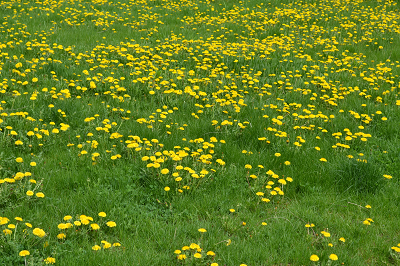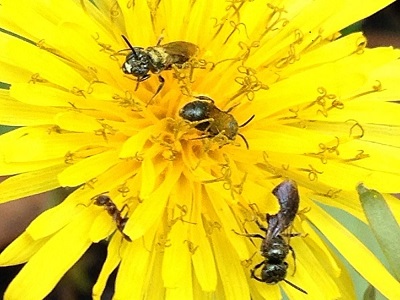by Renate Sander-Regier
Pollinators like imperfect lawns. They prefer them on the derelict side. Pollinators are, in fact, drawn to lawns that stray from the closely clipped, green-carpet ideal.
For those of us who don’t like to mow, this is good news. We now have one more reason – evidence-based – to put off mowing and neglect the grass in our yards.
Recently published research reveals that pollinators benefit from lawns that are mowed every two weeks rather than every week. During the longer period, flowering plants have time to bloom, offering pollen and nectar to bees and other pollinating insects.
The study, conducted by researchers from multiple institutions, experimentally tested whether different lawn mowing frequencies (1, 2, or 3 weeks) influenced bee abundance and diversity in 16 herbicide-free suburban yards in Springfield Massachusetts. Although limited, the research nevertheless yielded interesting and complex results (see links below for details).
In those 16 lawns, the researchers recorded 93 bee species – roughly a quarter of all bees species found in the state and including one not documented in Massachusetts since the 1920s. Additional observations raised the number of bee species to 111.
“I was amazed at the high level of bee diversity and abundance we documented in these lawns,” one of the researchers, Joan Milam, is quoted as saying. “It speaks to the value of the untreated lawn to support wildlife” (see “Lazy lawn mowers” can help…).
More research is admittedly needed to establish whether or not varying lawn mowing frequencies would have similar results in other locations, including sites such as golf courses, athletic fields, and other residential lawns. Yet the researchers stress that the study demonstrates the capacity for properly managed urban environments to provide appropriate habitat for many bees.
“Cities may harbor even more diverse and abundant populations of native bees than nearby natural areas,” adds Susannah Lerman, lead author of the study. “Lawns managed to promote bees have the potential to improve bee abundance” (see Mowing the lawn less often…).
So don’t bother mowing this weekend. Let the dandelions and clover grow and bloom. Your neighbourhood bees will appreciate it.
Read more
Summaries of the research
- Bees love the lawns of lazy homeowners
- “Lazy lawn mowers” can help support suburban bee populations and diversity
- Mowing the lawn less often improves bee habitat
The full research article
To mow or to mow less: Lawn mowing frequency affects bee abundance and diversity in suburban yards (gated)
Renate Sander-Regier has a passion for wild bees. She seeks to encourage them and other native pollinators in different habitat planting projects – at her rural home, the Fletcher Wildlife Garden, the University of Ottawa campus, and more.

